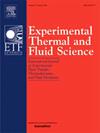Study on the microscopic characteristics of successive droplet clusters impacting on the wall
IF 3.3
2区 工程技术
Q2 ENGINEERING, MECHANICAL
Experimental Thermal and Fluid Science
Pub Date : 2025-09-17
DOI:10.1016/j.expthermflusci.2025.111619
引用次数: 0
Abstract
In Direct Injection Spark Ignition (DISI) internal combustion engines, fuel droplets inevitably impact the cylinder walls, resulting in droplet adhesion and incomplete combustion, thereby increasing pollutant emissions. The injection strategy has been proven to significantly improve the droplet-wall interaction. Initially, the Refractive Index Matching (RIM) method was used to measure fuel adhesion under both single and double injection conditions, with results confirming that the double injection strategy significantly reduced the fuel adhesion mass. To investigate the mechanisms underlying the reduction in fuel adhesion with double injection, Particle image analysis (PIA) and a multiple droplets producer were employed to examine the micro-behavior of successive droplet clusters near the wall surface. Statistical analyses were conducted on droplet size and velocity. Results showed that, when the two successive droplet clusters impact the wall, the Sauter Mean Diameter (SMD) of the second cluster is greater than that of the first cluster. There are two reasons for this. First, this difference is attributed to the coalescence between the leading droplets of the second droplet cluster and the trailing droplets of the first droplet cluster. Second, when the second droplet cluster impacts the wall, the breakup of fuel adhesion can also lead to the formation of larger droplets. Moreover, the second droplet cluster exhibits a significantly higher penetration velocity than that of the first, which can be attributed to the interaction of the velocity fields between the trailing droplets of the first cluster and the leading droplets of the second cluster. Furthermore, analysis of the average minimum droplet distance shows that droplet number density near the wall is relatively high and decreases with increasing distance from the wall. Lastly, the Bai model was used to predict the probabilities of stick, rebound, spread, and splash of successive droplet clusters at various observation points.
连续液滴簇撞击壁面的微观特性研究
在直喷式火花点火(Direct Injection Spark Ignition, DISI)内燃机中,燃油液滴不可避免地会撞击汽缸壁面,造成液滴粘附,燃烧不完全,从而增加污染物排放。该注入策略已被证明可以显著改善液滴-壁面相互作用。首先,使用折射率匹配(RIM)方法测量了单次和双次喷射条件下的燃油粘附质量,结果证实双次喷射策略显著降低了燃油粘附质量。为了研究双重喷射降低燃油粘附的机制,采用粒子图像分析(PIA)和多液滴产生器对壁面附近连续液滴团的微观行为进行了研究。对液滴大小和速度进行了统计分析。结果表明,当连续两个液滴团撞击壁面时,第二个液滴团的Sauter Mean Diameter (SMD)大于第一个液滴团。这有两个原因。首先,这种差异归因于第二个液滴团的先导液滴和第一个液滴团的尾随液滴之间的聚并。其次,当第二液滴簇撞击壁面时,燃料黏附的破裂也会导致更大液滴的形成。第二液滴团的穿透速度明显高于第一液滴团,这可能是由于第一液滴团尾部液滴与第二液滴团前导液滴之间的速度场相互作用所致。此外,对平均最小液滴距离的分析表明,液滴数密度在壁面附近较高,且随着离壁面距离的增加而减小。最后,利用Bai模型预测了不同观测点连续液滴团的粘附、反弹、扩散和飞溅概率。
本文章由计算机程序翻译,如有差异,请以英文原文为准。
求助全文
约1分钟内获得全文
求助全文
来源期刊

Experimental Thermal and Fluid Science
工程技术-工程:机械
CiteScore
6.70
自引率
3.10%
发文量
159
审稿时长
34 days
期刊介绍:
Experimental Thermal and Fluid Science provides a forum for research emphasizing experimental work that enhances fundamental understanding of heat transfer, thermodynamics, and fluid mechanics. In addition to the principal areas of research, the journal covers research results in related fields, including combined heat and mass transfer, flows with phase transition, micro- and nano-scale systems, multiphase flow, combustion, radiative transfer, porous media, cryogenics, turbulence, and novel experimental techniques.
 求助内容:
求助内容: 应助结果提醒方式:
应助结果提醒方式:


